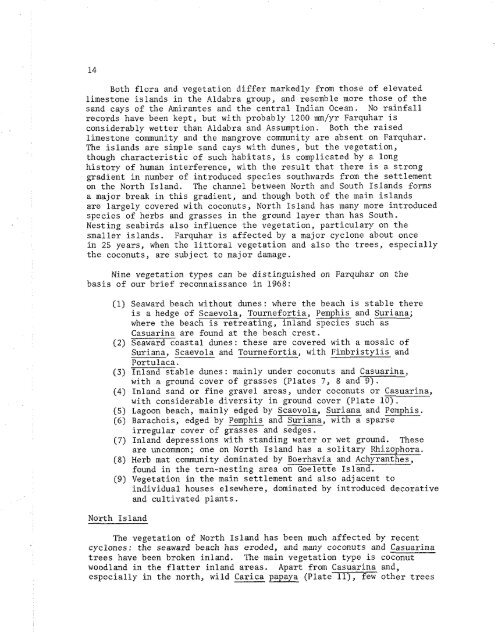ATOLL RESEARCH BULLETIN - Smithsonian Institution
ATOLL RESEARCH BULLETIN - Smithsonian Institution
ATOLL RESEARCH BULLETIN - Smithsonian Institution
Create successful ePaper yourself
Turn your PDF publications into a flip-book with our unique Google optimized e-Paper software.
Both flora and vegetation differ markedly from those of elevated<br />
limestone islands in the Aldabra group, and resemble more those of the<br />
sand cays of the Amirantes and the central Indian Ocean. No rainfall<br />
records have been kept, but with probably 1200 mm/yr Farquhar is<br />
considerably wetter than Aldabra and Asswnption. Both the raised<br />
limestone community and the mangrove community are absent on Farquhar.<br />
The islands are simple sand cays with dunes, but the vegetation,<br />
though characteristic of such habitats, is complicated by a long<br />
history of human interference, with the result that there is a strong<br />
gradient in number of introduced species southwards from the settlement<br />
on the North Island. The channel between North and South Islands forms<br />
a major break in this gradient, and though both of the main islands<br />
are largely covered with coconuts, North Island has many more introduced<br />
species of herbs and grasses in the ground layer than has South.<br />
Nesting seabirds also influence the vegetation, particulary on the<br />
smaller islands. Farquhar is affected by a major cyclone about once<br />
in 25 years, when the littoral vegetation and also the trees, especially<br />
the coconuts, are subject to major damage.<br />
Nine vegetation types can be distinguished on Farquhar on the<br />
basis of our brief reconnaissance in 1968:<br />
(1) Seaward beach without dunes: where the beach is stable there<br />
is a hedge of Scaevola, Tournefortia, Pemphis and Suriana;<br />
where the beach is retreating, inland species such as<br />
Casuarina are found at the beach crest.<br />
(2) Seaward coastal dunes: these are covered with a mosaic of<br />
Suriana, Scaevola and Tournefortia, with Fimbristylis and<br />
Portulaca.<br />
(3) Inland stable dunes : mainly under coconuts and Casuarina,<br />
with a ground cover of grasses (Plates 7, 8 and 9).<br />
(4) Inland sand or fine gravel areas, under coconuts or Casuarina,<br />
with considerable diversity in ground cover (Plate 10).<br />
(5) Lagoon beach, mainly edged by Scaevola, Suriana and Pemphis.<br />
(6) Barachois, edged by Pemphis and Suriana, with a sparse<br />
irregular cover of grasses and sedges.<br />
(7) Inland depressions with standing water or wet ground. These<br />
are uncommon; one on North Island has a solitary Rhizophora.<br />
(8) Herb mat community dominated by Boerhavia and Achyranthes,<br />
found in the tern-nesting area on Goelette Island.<br />
(9) Vegetation in the main settlement and also adjacent to<br />
individual houses elsewhere, dominated by introduced decorative<br />
and cultivated plants.<br />
North Island<br />
The vegetation of North Island has been much affected by recent<br />
cyclones: the seaward beach has eroded, and many coconuts and Casuarina<br />
trees have been broken inland. The main vegetation type is coconut<br />
woodland in the flatter inland areas. Apart from Casuarina and,<br />
especially in the north, wild Carica papaya (Plate ll), few other trees

















